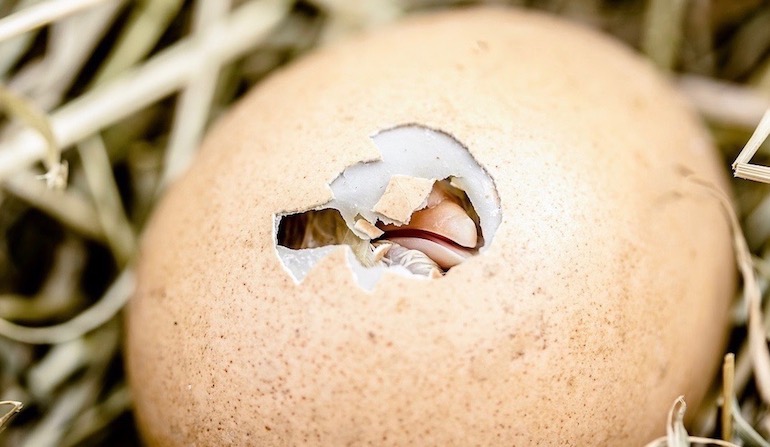 Evolution
Evolution
 Intelligent Design
Intelligent Design
Eggshell’s Remarkable Design — A Tribute to Mindless Evolution?


Scientists have revealed the delicately designed structure of bird eggs, combining remarkable strength with the capability of being cracked and pierced from within by an otherwise helpless chick in the process of hatching. The paper reporting this research, published in Science Advances, is striking with its references to “design.” Yet from this they derive a demonstration of…evolution and its mindless genius.
The key lies in a triple-layered structure and a protein called osteopontin. The Abstract summarizes:
Avian (and formerly dinosaur) eggshells form a hard, protective biomineralized chamber for embryonic growth — an evolutionary strategy that has existed for hundreds of millions of years. We show in the calcitic chicken eggshell how the mineral and organic phases organize hierarchically across different length scales and how variation in nanostructure across the shell thickness modifies its hardness, elastic modulus, and dissolution properties. We also show that the nanostructure changes during egg incubation, weakening the shell for chick hatching. Nanostructure and increased hardness were reproduced in synthetic calcite crystals grown in the presence of the prominent eggshell protein osteopontin. These results demonstrate the contribution of nanostructure to avian eggshell formation, mechanical properties, and dissolution.
A story in The Guardian translates:
Using a number of microscopy techniques, as well as a cutting-edge method known as focused-ion beam for preparing thin sections of the eggshell, the team found that all of the layers appear to be formed from an array of tiny areas packed with a crystalline calcium-containing mineral.
The team also found the areas are smaller and more closely arranged in the outer layer, with the nanostructure becoming larger towards the inner layers. Levels of osteopontin were found to be lowest in the innermost eggshell layer.
“The third discovery was that the outside of the shell is harder as it has the smallest [nanostructure] and then you move inwards and it gets a little bit softer,” said [Marc] McKee.
The team say the upshot is that osteopontin seems to form a sort of scaffold that guides the arrangement of calcium-containing mineral, generating a nanostructure that affects the hardness of the eggshell layer.
The researchers admire the “remarkably designed and evolutionarily persistent avian eggshell,” and they enthuse about the implications for developing new biomimetic technologies:
[T]he findings also potentially serve to inform rational designs for novel, bioinspired functional nanomaterials having desirable and tunable unique properties.
It’s “remarkably designed,” it can “inform design concepts.” Yet guess what? It’s all a tribute not to intelligent design but to unguided evolution. The Guardian quotes Marc McKee of McGill University:
“When you think about it, we should be making materials that are inspired by nature and by biology because, boy, it is really hard to beat hundreds of millions of years of evolution in perfecting something,” he said.
Read that again. Is he being snarky? The exclamation — “Boy, it is really hard to beat hundreds of millions of years of evolution in perfecting something”! — is oddly phrased. It’s the kind of thing an ID scientist might say in a moment of being temporarily overcome by sarcasm. No, I’m confident that Dr. McKee is in earnest. But he made me wonder there for a moment.
The complaint about seemingly imperfect design is often heard from Darwinists as a reason to say that apparent design in biology isn’t real design. An atheist brags about flummoxing an argument for ID based on the human eye by pointing out to an interlocutor, making a case for design, that he’s wearing eyeglasses. Yes, the eyes wear out with age. God wouldn’t do it that way! Neither would a clever human designer. After all, we know that human technology never wears out. Ergo, Darwinism.
Here the logic is exactly reversed. The design of the avian egg is so amazing, so worthy of imitation by human technology, that “when you think about it,” it’s all a magnificent tribute to unguided evolution. Boy, any clever human designer should rush to learn from this!
Is any observation, along with its opposite, not evidence for evolution? Sometimes, it seems not.
Photo credit: Myriams-Fotos, via Pixabay.
